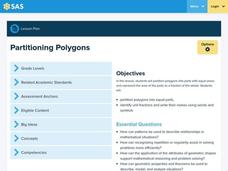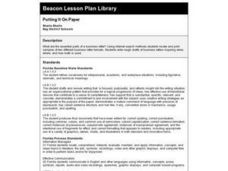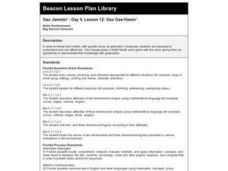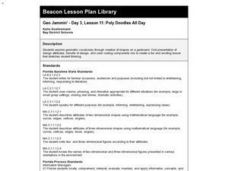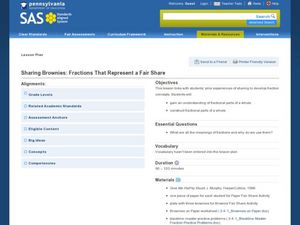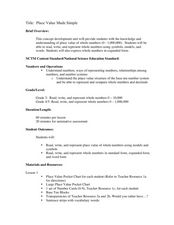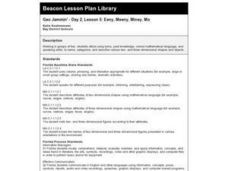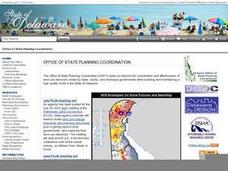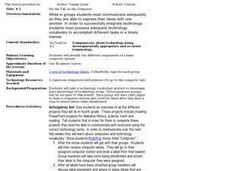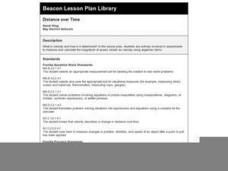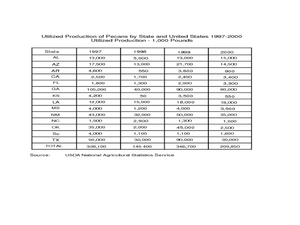Curated OER
Fraction Strips
Get a handle on equivalent fractions through the use of manipulatives. Using area models, sets, and length manipulatives like fraction strips and Cuisenaire rods, the class will gain a deeper understanding of equivalent fractions....
Curated OER
Naming Shapes
Students study geometric shapes and practice naming them properly. In this geometry lesson, students work in groups to give definitions of the vocabulary to each other in their own words. Students also visit a lower grade and teach...
Curated OER
Putting it On Paper
Students locate and print samples of two different business letter formats. They write rough drafts of business letters inquiring when, where, and how math is used.
Curated OER
Geo Jammin' - Day 4, Lesson 12: Geo Gee-Hawin'
Students review geometry unit content through a vocabulary/word game. They demonstrate understanding using geoboards to answer questions. They work in groups and it's a race to the correct answer.
Curated OER
Geo Jammin' - Day 3, Lesson 11: Poly Doodles All Day
Students explore geometric vocabulary through creation of shapes on a geoboard. They present design attributes, transfer of design, and color-coding components mix to create a fun and exciting lesson plan that stretches student thinking.
Curated OER
Come Tool Along With Me
Young scholars create metallic Bas-relief scultures using basic art supplies and the technique of "tooling" in this Art instructional activity with croos-curricular connections in Social Studies and Math. A scoring rubric is included for...
Pennsylvania Department of Education
Using Polygons to Represent Fractions
Explore the world of fractions by using pattern blocks to show how different shapes can divide a hexagon. Elementary schoolers work in groups to complete these problems and to answer questions. Later, they work complete an independent...
Curated OER
Sharing Brownies: Fractions That Represent a Fair Share
Elementary graders discover the concept of fractional pieces of a whole. They investigate the meanings of fractions in everyday life and why they are used. Pupils divide brownies amongst each other to demonstrate the use of fractions...
Curated OER
Place Value Made Simple
Elementary schoolers explore place value to the millions place. They construct and evaluate the value of numbers. Working in small groups, pupils problem solve with pocket place value charts, and examine standard and expanded forms. This...
Pennsylvania Department of Education
What is the Chance?
Fourth and fifth graders make predictions using data. In this analyzing data instructional activity, pupils use experimental data, frequency tables, and line plots to look for patterns in the data in order to determine chance. You will...
Curated OER
Geo Jammin' - Day 2, Lesson 5: Eeny, Meeny, Miney, Mo
Students, in groups, use song lyrics and math to descrie two and three dimensional shapes.
Curated OER
Chances Are: Talking Probability
Students explore probability and the process of data analysis and predictions. They participate in two activities, one involving a calculator and one the Internet, in which they make predictions and conduct activities to test their...
Curated OER
Reflections of Symmetry
Students use video and the Internet to identify examples of bilateral and radial symmetry in the world around them. They create symmetrical reflection designs using pattern blocks and paper.
Curated OER
Best Friend - Friend from Hell
Students practice in a number of areas: expressing opinions, using comparatives and superlatives, descriptive adjectives and reported speech. The overall concept of this lesson can be applied to many other topics of discussion.
Curated OER
Children's Literature Across the Curriculum Ideas-Lilly's Purple Plastic Purse
Students read Lilly's Purple Plastic Purse by Kevin Henkes. They complete a variety of cross-curricular activities surrounding events of the story. Included are reading, art, math, science, writing, social studies, and library connections.
Curated OER
Variables and Open Sentences
Fourth graders examine the purpose of variables and identify the missing variable in open sentences. They observe the teacher solve a variety of problems, complete a worksheet as a class, and independently complete another worksheet. ...
Curated OER
Equivalent Fractions
Students complete a worksheet. For this fractions lesson, students review their knowledge of fractions, define equivalent fractions, see examples of equivalent fractions and practice making equivalent fractions.
Curated OER
Copy Cat
Students examine a Webmath page, and demonstrate how to copy and paste. They create a computer-generated template page presenting the attributes of two- and three- dimensional shapes.
Curated OER
"Where in the World is my School?"
Students learn new vocabulary and discuss what GPS is and does. They locate their school using the equipment.
Curated OER
Pin the Tail on the Computer
Students identify the basic components of the computer system. They watch a Brain Pop movie about computers and then draw a "vocabulary label" from a basket. The student is blindfolded and sticks the label on a picture of a computer....
Curated OER
Distance over Time
Learners analyze velocity and how it is determined. They experiment with velocity in order to measure and calculate the magnitude of speed. They use examples in their novel "Skateboard Renegade" to relate velocity to real life situations.
Curated OER
Addition Properties
Student study addition properties. For this addition properties lesson, young scholars use multiple methods to solve various types of problems. Students illustrate and describe in various ways the Commutative Property of Addition....
Curated OER
Pecan Power
Students study the origins of pecans and complete a bar graph from the data they have discovered. In this pecan lesson plan, students draw pecans, discuss a pecan time line, and draw a bar graph comparing Arizona pecans to other...
Curated OER
Tessellation Design And Construction
Students study the basic elements and concepts of the visual art's perceptual component - such as shape, line and color. They create tessellations that foster problem solving and reflective thinking.
